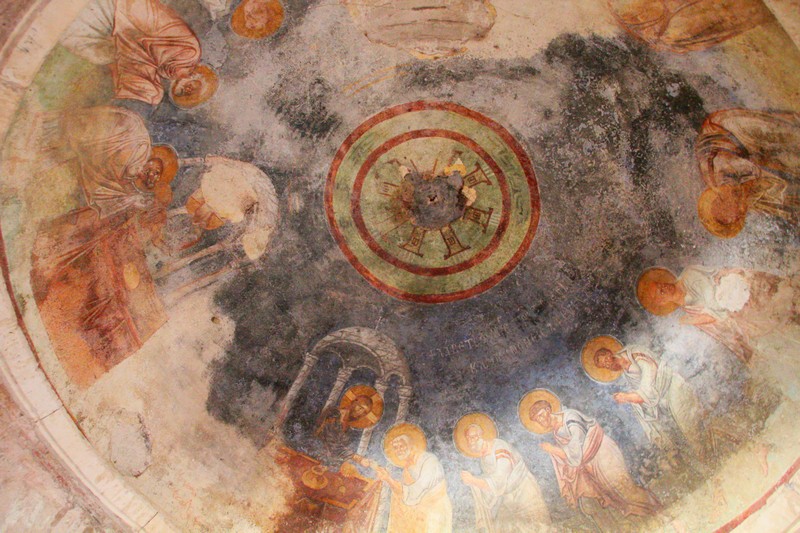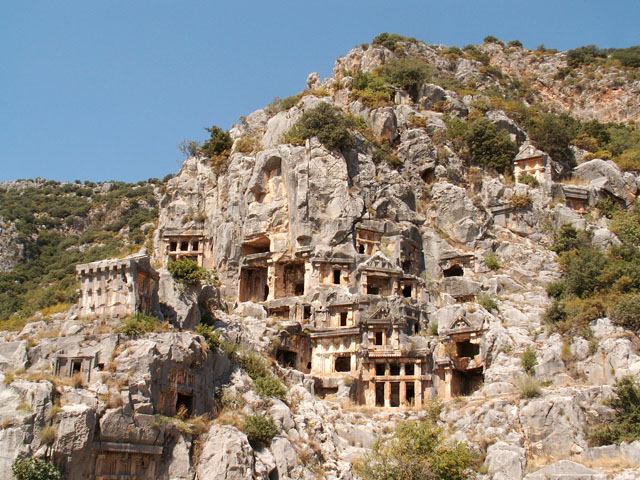Have you heard of Demre, Turkey? It’s on the southwest Mediterranean coast, in the Antalya Province. And, it’s the town of three names – currently named Kale, although no one calls it that. Most people head to Demre to visit the church of St. Nicholas (more on that in a bit). But Demre is the current name of the ancient Lycian city of Myra, which was the capital of Lycia. In fact, if you’re any kind of history or archaeology buff, Demre is the place to go.
What to see in Demre
Santa Claus
Let’s get the white elephant out of the room, shall we? Indeed, Santa Claus – St. Nicholas, to be honest – lived and worked in Demre. In his lifetime (270-343), he rose to bishop in Myra (the name of the down derived from the word myrrh). He was the only son of wealthy parents, who died while he was young. He was raised by his uncle, the Bishop of Patara (talk about training for future career!). There are many legends about St. Nicholas, including that he’d drop bags of gold (!) down the chimneys of poor women that couldn’t afford a dowry, and leave gold coins in shoes left out for him. He is a great favorite of sailors and fishermen, sometimes even being called the Lord of the Sea, a la Poseidon (albeit with a Christian slant). This is ironic, since he worked hard to stamp out paganism, even destroying a temple to Artemis. He is celebrated with a feast day on December 6. In Demre, you can visit his church (the Church of St. Nicholas at Myra). You’ll see an ancient building (8th c onward), partially excavated. The floor of the church is beautifully colored marble, and there are some remains of frescoes. The original tomb of St. Nicholas is also here (his remains are interred elsewhere).
Statue of St Nicholas. Wikimedia Commons: Hippolyte

Frescoe, Church of St. Nicholas. Wikimedia Commons: Николай Слета

Sarcophagus of St Nicholas. Wikimedia Commons: Sjoehest
Ruins
Roman Myra
An enormous amphitheatre, the largest in Lycia. It’s in good shape, and features 38 rows of seats. You can also see carved masks on some of the stones!

Wikimedia Commons: Ingo Mehling
Rock-cut tombs
There are two sets of these, actually. Some are right above the amphitheatre, while the others are on the east side, at the river necropolis. The tombs are cut into the steep cliffs, and were previously painted! Most of the tombs are from the 4th c BC. The most famous monument is located near the Amphitheatre, and is called the Painted Tomb.

Wikimedia Commons: Simm
Çayağzı (Roman Andriake)
In this harbor city of Myra, you can see the remains of the granary that Emperor Hadrian built in 131. There are also ruins of the ancient town, and the ruins of the first synagogue found in ancient Lycia.

Wikimedia Commons: Babbsack
Kekova-Simena
A UNESCO heritage nominated site, Kekova (the ancient Lycian city of Simena) is a sunken city! The city is half submerged, half above water. Sunken during an earthquake in the 2nd century, you can see staircases descend into the water, and foundations and the ancient harbor underwater. Tour boats aren’t allowed too close to the ruins, so see if you can book a sailboat, to get closer. There are also ruins on land, for you land lubbers.

Wikimedia Commons: Htkava

Wikimedia Commons: Seynaeve

